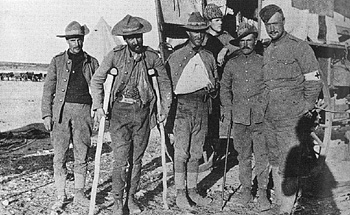Battles
Faber's Put
30 May 1900
 Wounded survivors of “E” Battery, RCFA, after the battle of Faber’s Put, 30 May 1900.
Wounded survivors of “E” Battery, RCFA, after the battle of Faber’s Put, 30 May 1900.As the main British offensive neared the Transvaal capital of Pretoria, other forces, columns of predominantly 'colonial' and Imperial Yeomanry (British militia mounted infantry) were pursuing Boer forces in the northern and western Cape Colony. In late May, one of these columns, which included four guns of "E" Battery, Royal Canadian Field Artillery, halted to wait for supplies at Faber's Put. The choice may have been due to the presence of a comfortable farm house, which the British commander appropriated as his living quarters. The choice was not a good one, as a number of ridges within rifle range overlooked the farm buildings.
That evening, 600 Boers surrounded the position. A party of Boers crept past the British outposts and into the camp under the cover of darkness. Dawn was still a half hour away when a sentry raised the alarm. The Boers poured fire into the mounted infantry lines, killing men and scattering scores of horses. In the Canadian lines (See Map), next to the British, the gun detachments ran to their 12-pounder guns, while the drivers harnessed the horses and led them to safety. It was still too dark to aim the guns, so the gunners lay prone beside them.
As the sun rose, a British unit recruited in South Africa counter-attacked, while the Yeomanry engaged the Boers at close range. Two Canadian nine-member gun teams manhandled two guns across a fire-swept field and brought them into action, losing one man killed and seven wounded in the process. The combination of the counter-attack and the artillery fire was too much for the Boers, who abandoned the battle.
Although the British commander claimed victory, down-playing the casualties of 27 killed and 41 wounded and the loss of a large number of horses, the engagement was, in fact, a defeat. Nevertheless, the Canadian battery had fought one of the most desperate actions faced by Canadians while campaigning in South Africa, and gained little recognition for its efforts.
